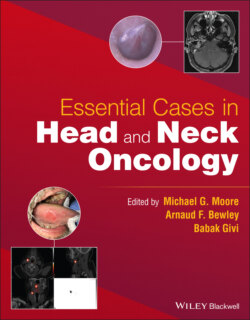Читать книгу Essential Cases in Head and Neck Oncology - Группа авторов - Страница 25
Key Points
ОглавлениеEvaluation of oral cavity cancer starts with a biopsy and typically a CT scan of the face and neck with IV contrast to assess the extent of the primary lesion and to evaluate for regional lymphadenopathy. An MRI may be indicated if there is concern for significant perineural invasion, deep tongue invasion, or extension near the orbit, skull base, or parapharyngeal space. The use of PET/CT should be in patients with stage III or IV disease.
Management of tumors of the maxillary alveolus typically involves upfront surgery with removal of the primary tumor with clear surgical margins. A neck dissection should be performed for pathologic lymphadenopathy. For cN0 patients, elective neck dissection should be considered for advanced (T3 or T4) primary tumors as it may improve cancer control. more recent evidence suggests elective neck dissection in T2 tumors or consideration of sentinel node biopsy to determine the need for neck dissection.
Adjuvant radiation therapy should be considered for advanced primary tumors, the presence of lymph node metastases, perineural invasion, lymphovascular invasion, or close surgical margins.
Adjuvant chemoradiotherapy should be recommended in instances of positive surgical margins and/or the presence of extracapsular spread in cervical lymph nodes.
In patients where a maxillectomy is considered, options for reconstruction include the use of a maxillofacial prosthesis or the use of a regional or free flap. If a maxillary obturator is planned, it is essential to have the patient see a maxillofacial prosthodontist soon after diagnosis to allow for a prosthesis to be made prior to the day of the resection.
In instances when there is resection of the orbital floor or orbital exenteration, or when there will be inadequate remaining dentition to retain an obturator, reconstruction with free tissue transfer should be considered in suitable candidates.
